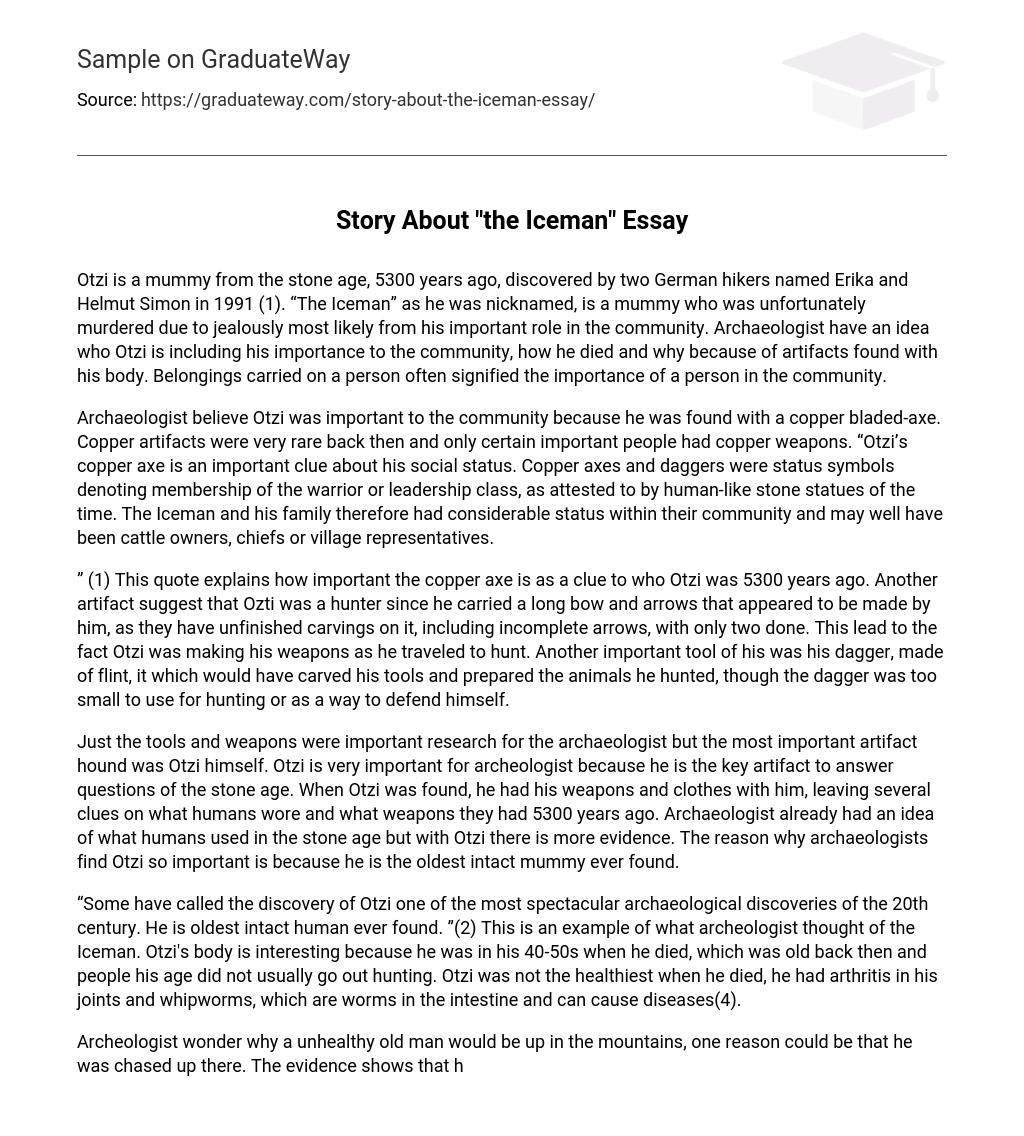Otzi, also known as “The Iceman,” is a mummy that dates back to the stone age, approximately 5300 years ago. He was discovered by Erika and Helmut Simon, two German hikers, in 1991(1). It is believed that Otzi was murdered due to jealousy, possibly because of his significant role in the community. Archaeologists have been able to gather information about Otzi’s identity, his importance within the community, the cause of his death, and the possible motives behind it by studying the artifacts found with his body. The belongings carried by an individual often indicated their significance within the community.
Archaeologists believe that Otzi played an important role in his community because he owned a copper bladed-axe. At the time, copper artifacts were rare and only reserved for respected individuals. The fact that Otzi had a copper axe indicates his high social status. Copper axes and daggers were symbols of belonging to the warrior or leadership class, as evidenced by stone statues resembling humans from that era. Therefore, it can be concluded that Otzi and his family held prominent positions within their community, possibly as cattle owners, chiefs, or village representatives.
” (1) This quote emphasizes the significance of the copper axe as an indication of Otzi’s identity 5300 years ago. Another artifact suggests that Otzi was a hunter because he carried a long bow and arrows that appeared to be crafted by him, evidenced by unfinished carvings and incomplete arrows, with only two completed. This indicates that Otzi was producing his weapons while traveling for hunting purposes. Additionally, his flint dagger was a crucial tool for carving tools and preparing the animals he hunted; although it was too small for hunting or self-defense.
The archaeologist placed significant importance on studying both the tools and weapons, as well as the key artifact of Otzi, the ancient mummy. Otzi holds immense value for archaeologists as he provides crucial insights into the stone age. Upon discovery, Otzi was accompanied by his weapons and clothing, shedding light on the attire and weaponry of humans 5300 years ago. While archaeologists already possessed some knowledge of stone age practices, Otzi’s presence enables them to gather additional evidence. A significant reason why archaeologists consider Otzi to be of utmost significance is because he represents the oldest intact mummy ever discovered.
“The discovery of Otzi is considered one of the most remarkable archaeological findings of the 20th century. He is the oldest intact human ever unearthed.” (2) This exemplifies the perception of archaeologists regarding the Iceman. Otzi’s preserved body is intriguing due to his advanced age of 40-50 years at the time of his death, which was considered old during that era when individuals of his age group typically refrained from hunting. When Otzi passed away, his health was not in the optimum state as he suffered from arthritis in his joints and had whipworms, a type of intestinal worm that can lead to illnesses(4).
Archaeologists are intrigued by the presence of an elderly and ill gentleman in the mountains. A potential explanation is that he was pursued and forced to seek refuge there. The available evidence indicates that this man, who would not typically be found in such surroundings, perished alone. The circumstances surrounding Otzi’s death remained a perplexing enigma for years, as archaeologists offered various hypotheses without concrete evidence. Speculations included death by freezing, assault by wild animals, exposure to a blizzard, or homicide by fellow humans(3).
Archaeologists have found evidence of a flint arrowhead in Otzi’s left shoulder, indicating that he was the victim of homicide. To establish the connection between the arrowhead and Otzi’s death, archaeologists also identified an unhealed wound on his back. According to the discoveries, “an arrow went into his back, passed by his lung, and cut through an artery, causing him to die from blood loss” (2). If indeed Otzi was murdered, it is probable that a group of people carried out the act and Otzi likely tried to escape but ultimately died due to excessive bleeding.
Otzi, an older and unhealthy man, was struck with an arrow in the mountains, leading to his demise. Shortly after, snow and ice covered him, preserving his body in a frozen state. The discovery of Otzi is incredibly rare as finding fully intact mummies from the Stone Age is highly uncommon. However, this remarkable find provides valuable information for archaeologists regarding an individual’s identity, cause of death, and significance within their community. It is important to mention that Otzi perished 5300 years ago while alone in the unfamiliar mountainous terrain.
The discovery of his weaponry shed light on his significance to the community. In his possession was a copper axe, a rare artifact from that era, showcasing his importance. Additionally, a flint dagger implied he was a skilled hunter. Remarkably, his unhealed wound contained an arrowhead, suggesting that he had been shot. It is believed that he was murdered, possibly out of envy or by bandits. By piecing these clues together, archaeologists were able to construct a narrative about the Iceman. Ultimately, the most captivating aspect of Otzi’s story is his tragic demise, resulting from the loss of blood caused by an arrowhead lodged in his left shoulder.





